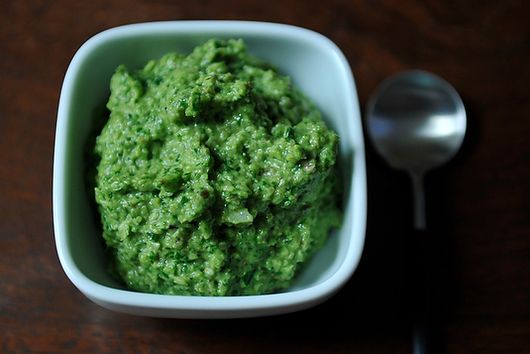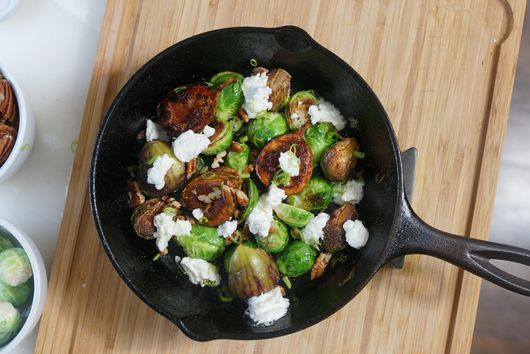Sourdough Fougasse
★★★★★
PREP TIME
2 hours
COOK TIME
25 minutes
MAKES
two 800g fougasses (about the size of a half-sheet pan)
Ingredients
711 grams
all-purpose flour
125 grams
whole-wheat flour
35 grams
extra-virgin olive oil
15 grams
kosher salt
544 grams
water
167 grams
ripe sourdough starter
Instructions
-
Mix the dough (10:00 a.m., or when your sourdough starter is ripe)
Add the flour, salt, water, and ripe sourdough starter to the bowl of a stand mixer fitted with the dough hook attachment. This dough is rather firm before we add the olive oil—expect it to ball up around the dough hook quickly. Turn the mixer on to speed 1 (STIR on a KitchenAid) for 1 minute until everything is incorporated. Then, turn the mixer up to speed 2 and mix for 1 to 2 minutes until the dough balls up around the dough hook. Let the dough rest for 10 minutes.
Turn the mixer on to speed 1 and slowly drizzle in the olive oil as the mixer is running. Once you have added all the oil and it’s mostly absorbed into the dough, turn the mixer up to speed 2 and continue mixing for 2 to 3 minutes until all of the oil is absorbed and the dough begins to soften. The dough will not completely form a firm ball around the dough hook, but it will start showing signs of smoothness and elasticity (strength). Transfer the dough to another bowl or container for bulk fermentation. -
Bulk ferment the dough (10:30 a.m. to 1:30 p.m.)
Cover the dough and let it rise at room temperature (72 to 74°F) for a total of three hours. You’ll give the dough three sets of “stretch and folds” to impart additional strength during this time. Set a timer for 30 minutes and let the dough rest, covered. After 30 minutes, give the dough its first set of stretch and folds.
Use slightly wet hands to grab the dough farthest from you in the container for each set, stretch it up and over to the side nearest you. Then, grab the dough on the side closest to you and stretch it back up and over to the farthest side of the container. Repeat two more folds, one at the right side of the container and one at the left—you’ll now have a folded up square in the container. Let the dough rest, again covered and at room temperature, for 30 minutes, stretching and folding again. Repeat this process one more time for three total sets. After the third set, let the dough rest, covered, for the remaining time in bulk fermentation. -
Preshape the dough (1:30 p.m.)
After three hours, your dough should have risen in your bulk fermentation container to be smooth and strong. Gently scrape out your dough to an unfloured work surface, divide it in half, and preshape each half into a round shape. Leave the rounds to rest, uncovered, for 30 minutes. -
Shape the dough (2:00 p.m.)
Prepare two pieces of parchment paper the size of a half-sheet pan. Lightly grease the top of the parchment paper with olive oil by smearing it with your hands. Working with one preshaped round at a time, scoop the dough up and place it directly in the middle of the parchment paper.
Using a rolling pin, gently roll the dough out to an oval shape that has even thickness and fills about two-thirds of the parchment paper’s length. Avoid excessively pressing down the dough with the rolling pin as you roll it outward; press down just enough to encourage it to spread. Once you have an elongated oval on the parchment paper, coax the oval’s bottom outward toward the left and right edges, so the overall shape is a rough triangle. -
Proof the dough (2:30 p.m. to 4:00 p.m.)
Drag each piece of parchment paper with the dough on top into separate half-sheet pans. Cover each with a reusable plastic bag or kitchen towel to keep the dough from drying out. Let the dough proof for 1 hour at room temperature.
After 1 hour, remove the covers and let the dough proof for 30 more minutes exposed to air (this will slightly dry the dough and make shaping the fougasse easier). At this time, also heat your oven with one oven rack positioned in the bottom-third, and one in the top-third, to 450°F (230°C). -
Cut and top the dough (4:00 p.m.)
It’s time to cut and top the dough. Gather your toppings: olive oil, herbes de Provence, and coarse sea salt. You will also need a pizza wheel (or bench scraper) to cut the dough, and a pastry brush for spreading the olive oil.
To cut and shape the dough like a leaf, make a series of short cuts in the dough’s middle starting from the triangle’s base, working your way up to the top. While cutting each one, gently spread the dough with your fingers to encourage it to open. Once you’ve made all three cuts, use your hands to reach under the dough and spread it apart and outward, so the cuts are very open. Then, make diagonal cuts from the center cuts outward toward the triangle’s left and right sides (see step-by-step recipe images for a visual). When making each cut, reach under the dough and gently spread it outward to encourage the cut to extend open and wide.
Once you’ve cut the dough, generously spread the olive oil to top every part of the dough’s surface. Next, sprinkle on any additional herbs and the coarse sea salt.
Repeat for the second fougasse. -
Bake the fougasse (4:30 p.m.)
Slide both pans into the oven and bake at 450°F (230°C) for 25 to 30 minutes, rotating the pans 180° halfway through the baking time. Check on each fougasse after 20 minutes to ensure it’s not coloring too quickly. They’ll be done when the top and bottom are golden. The longer you bake them, the crispier the result.
When finished baking, remove the fougasse from the oven and dot with olive oil using a pastry brush. These flatbreads are best eaten warm from the oven but will keep very well the day they’re baked. If eating the next day, briefly warm under the broiler to soften before serving.





